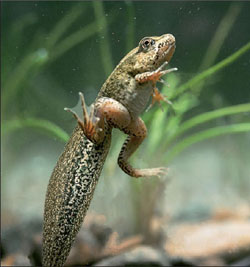Early Tetrapods and Modern Amphibians
 |
| A pickeral frog, Rana palustris, during metamorphosis. |
The chorus of frogs beside a pond on a spring evening heralds one of nature’s dramatic events. Masses of frog eggs soon hatch into limbless, gill-breathing, fishlike tadpole larvae. Warmed by the late spring sun, they feed and grow. Then, almost imperceptibly, a remarkable transformation takes place. Hindlegs appear and gradually lengthen. The tail shortens. Larval teeth are lost, and gills are replaced by lungs. Eyelids develop. Forelegs emerge. In a matter of weeks the aquatic tadpole has completed its metamorphosis to an adult frog.
The evolutionary transition from water to land occurred not in weeks but over millions of years. A lengthy series of alterations cumulatively fitted the vertebrate body plan for life on land. The origin of land vertebrates is no less a remarkable feat for this fact—a feat that incidentally would have a poor chance of succeeding today because wellestablished competitors make it impossible for a poorly adapted transitional form to gain a foothold.
Amphibians are the only living vertebrates that have a transition from water to land in both their ontogeny and phylogeny. Even after some 350 million years of evolution, few amphibians are completely land adapted; most are quasiterrestrial, hovering between aquatic and land environments. This double life is expressed in their name. Even amphibians that are best adapted for a terrestrial existence cannot stray far from moist conditions. Many, however, have developed ways to keep their eggs out of open water where their larvae would be exposed to enemies.
Adaptation for life on land is a major theme of the remaining vertebrate groups. These animals form a monophyletic unit known as tetrapods. Amphibians and amniotes (including reptiles, birds, and mammals) represent the two major extant branches of tetrapod phylogeny. In this section, we review what is known about the origins of terrestrial vertebrates and discuss the amphibian lineage in detail. We discuss the major amniote groups in Reptilian Groups , Birds and Mammals .
Position in the Animal Kingdom
Amphibians are ectothermic, primitively quadrupedal vertebrates, with glandular skin and dependence on water for their reproduction. They are one of two major groups of living descendants of early Devonian tetrapods, the first vertebrates to evolve adaptations to breathe, support themselves, move, and detect airborne sounds and odors on land, while minimizing water loss. The other group is the amniotes: reptiles, birds, and mammals that completed movement onto land by evolving adaptations that freed them from their dependence on water for reproduction.
Biological Contributions
- Strong skeletal framework to support body weight on land, and the tetrapod leg with associated shoulder/hip girdle for walking on land.
- A respiratory system with lungs (some modern amphibians are gilled, and some lack both lungs and gills) and paired internal nostrils (choanae), which enable breathing through the nose.
- Double circulation with functionally separated pulmonary and systemic circuits and a three chambered heart. Pulmonary arteries and veins supply the lungs and return oxygenated blood to the heart.
- Ancestral aquatic sensory receptors were modified for life on land. The ear with tympanic membrane (eardrum) and stapes (columella) for transmitting vibrations to the inner ear is designed to detect airborne sounds. For vision in air, the cornea rather than the lens became the principal refractive surface for bending light; eyelids and lachrymal glands evolved to protect and wash the eye. A well-developed olfactory epithelium lining the nasal cavity evolved to detect airborne odors.




